Development of a battery-operated floatingelectrode dielectric barrier discharge plasma device and its characteristics
2021-06-21YaweiLIU刘亚韪SenWANG王森RusenZHOU周儒森ZhiFANG方志andKostyaKenOSTRIKOV欧思聪
Yawei LIU(刘亚韪),Sen WANG(王森),∗,Rusen ZHOU(周儒森),Zhi FANG(方志),∗and Kostya(Ken)OSTRIKOV(欧思聪)
1 College of Electrical Engineering and Control Science,Nanjing Technology University,Nanjing 211816,People’s Republic of China
2 School of Chemistry and Physics and QUT Centre for Materials Science,Queensland University of Technology(QUT),Brisbane,Queensland 4000,Australia
Abstract In this work,a portable floating-electrode dielectric barrier discharge(FE-DBD)device is designed with a rechargeable battery as the power supply.The characteristics of the FE-DBD with a metal electrode and human hand are studied and compared.The human contact safety is verified by calculating the current through the human body based on the equivalent circuit model.Escherichia coli inactivation experiments confirm the efficacy of the FE-DBD device in the envisaged applications.
Keywords:floating-electrode dielectric barrier discharge,portable plasma source,human contact safety,bacterial inactivation
1.Introduction
Dielectric barrier discharge(DBD)plasmas have been attracting significant attention in the field of materials modification,environmental protection,microorganism sterilization,biomedicine[1–5].The key reason is that the DBDs can produce non-equilibrium plasma with high chemical activity under mild conditions[6,7].Generally,the reactor structure is one of the most important factors that affect the plasma characteristics and the energy efficiency of the power supply.Various DBD devices,such as parallel plate-to-plate,needleto-plate,coaxial structures,and surface DBD,etc,have been designed to meet different application requirements[5,8–11].In recent years,with the in-depth research of plasma applications in biomedicine,the demand for the specific embodiment of the DBD has become more diverse.The common DBD configuration has two fixed electrodes which cannot be moved during the treatment of objects,and cannot meet the safety requirements when plasmas directly contact the human body.Floating electrode(FE)-DBD is a discharge,in which plasma is generated between the high-voltage electrode surrounded by an insulating medium and the treated sample,which is not grounded but remains at a floating potential[12].Compared with the common DBD,FE-DBD is free to move,with the advantages of flexibility and convenience of operation.Researchers have designed FE-DBD devices and conducted research on their applications.Fridman et al designed an FE-DBD device for the skin sterilization of live mice,and the result showed that no damage was observed on the living tissue,and the live mice remained healthy after 10 min of the plasma treatment[13].Tiede et al designed a DBD source with a floating electrode excited by a μs-pulsed power to treat human skin fibroblasts[14].Kalghatgi et al presented research on the blood coagulation by the FE-DBD plasma,and the treatment hardly changed the properties of blood but effectively promoted blood coagulation[15].However,the existing FE-DBD devices require an external large-volume power supply from mains,leading to their limited portability.Designing a battery-powered FE-DBD device is a promising approach to solve this problem.Here,the high-voltage power supply should be small enough to be integrated with the electrode to improve the portability.In addition,though some researches indicate the safety of FEDBD working with living organisms or human bodies[13,16],the theoretical verification and control of human contact safety are also lacking,which limits the application of FE-DBD.
In this paper,a novel FE-DBD device driven by a rechargeable battery-powered microsecond pulse power supply is developed and tested in applications.The device integrates the power supply and the electrode to reduce the volume and improve the portability.By matching the electrode and power supply,the device can be touched directly with the human body,and the safety in contact with the human body is analyzed via the calculation of the current through the human body based on the equivalent circuit model.Bacterial inactivation experiments have also been carried out to demonstrate the good application prospects of the designed FE-DBD device in the field of plasma medicine.
2.The design of the FE-DBD device
The key part of the design portable FE-DBD plasma source is the power supply,whose schematic diagram is shown in figure 1(a).The power supply is composed of a boost circuit,a pulse width modulation(PWM,NE555DR)generator,an insulated gate bipolar transistor(IGBT,FGA25N120ANTD,25 A 1200 V)module and a step-up transformer.To facilitate portability,a rechargeable battery with a 7.4 V voltage and a capacity of 2200 mAh is employed to restore and supply the power.The boost circuit is designed based on an XL6009 chip with the advantages of simple structure and small size.The applied DC voltage on the IGBT is the output voltage of boost circuit,which is adjustable(up to 50 V).The PWM generator(a square wave generating module with adjustable duty cycle)is used to generate a control signal to drive the IGBT,transforming the DC voltage to a pulse voltage.The PWM generator(NE555DR),with an IGBT driver(MC33153DG)in the internal circuit,has the advantages of high stability,simple peripheral circuit and low cost,compared with a single IGBT driver,therefore,the PWM generator is selected to drive the IGBT.A DC–DC converter is connected before the PWM generator to obtain a suitable voltage for the PWM.The pulse voltage can be risen to a kilovolt-level by a transformer with the turns ratio of 1:30.EE type magnetic core and MXO-2000 ferrite with the permeability μ=2000 H m-1are employed to make the transformer.The output pulse voltage is adjustable in the range of 7–12 kV.The output voltage of the designed pulsed power supply is shown in figure 1(b).The result shows that the voltage frequency is 1 kHz,the rising time and the pulse duration of pulse voltage are 2.5 μs and 4.5 μs,respectively.
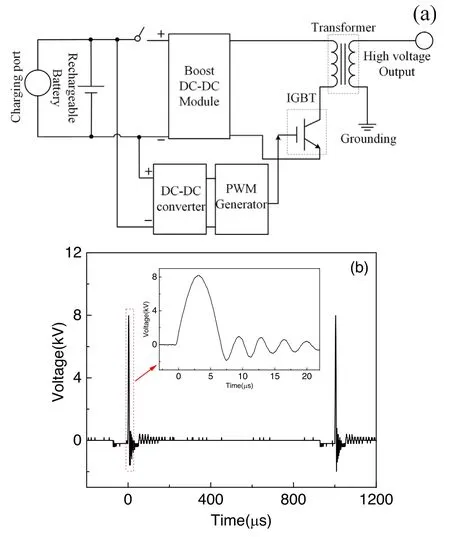
Figure 1.(a)Schematic diagram of the power supply,(b)the output voltage of designed pulsed power.
For the device shell,its mechanical properties are the primary consideration,which should resist any mechanical damage to protect the power supply and control system.Additionally,the heat dissipation capacity is also an important design specification.Therefore,the aluminum alloy is selected as the device shell.In terms of the floating electrode,a copper pillar with the diameter of 50 mm is selected as the electrode covered with corundum as the dielectric for its resistance to high temperature,high voltage and corrosion.The FE-DBD device is in the size of 56 mm × 56 mm ×150 mm and the mass of 800 g.The device appearance and discharge images with a metal electrode and human hand are shown in figure 2.
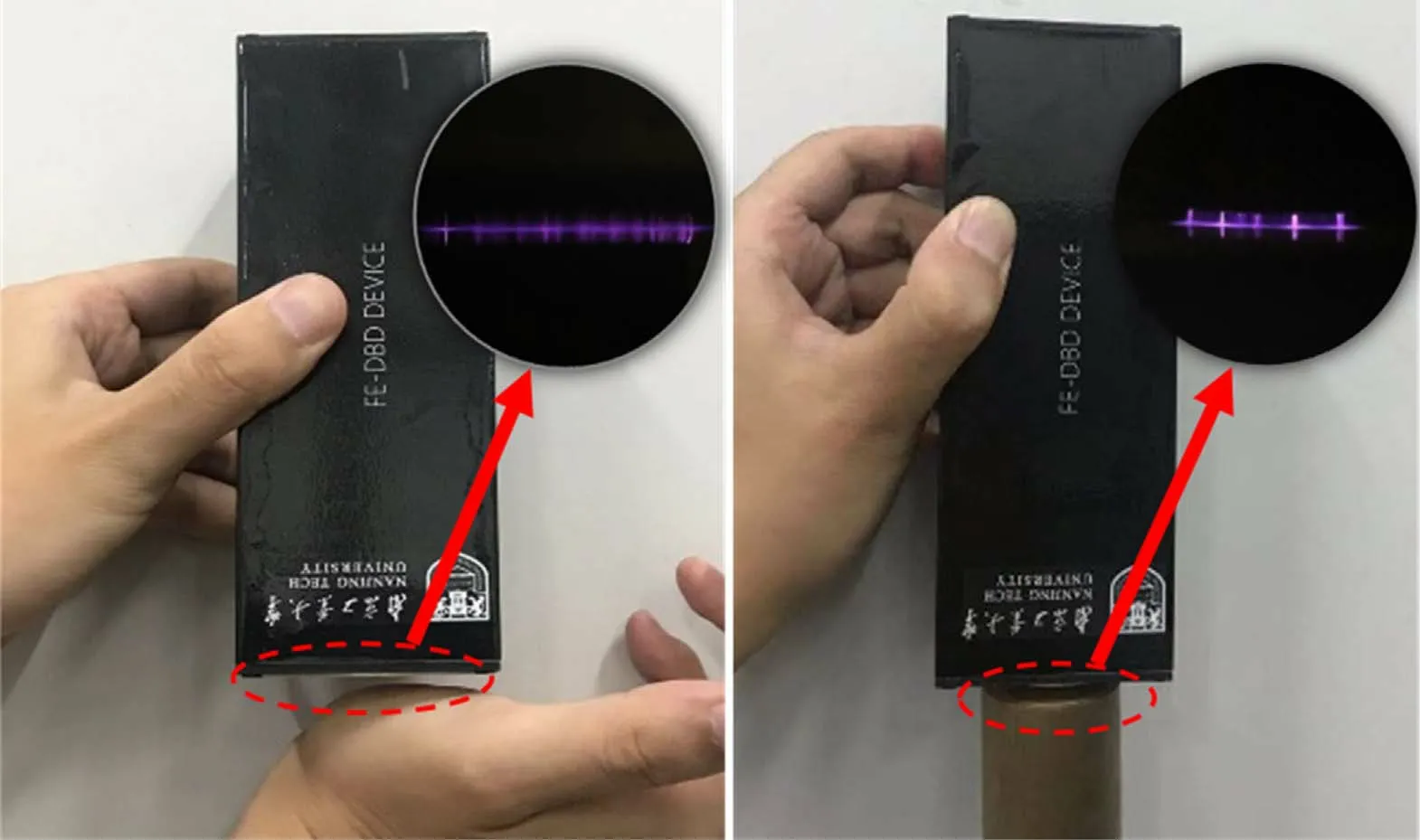
Figure 2.The appearance of the portable FEDBD device and the discharge with the human hand and metal electrode.
To test the stability of the FE-DBD device under a long operation,the output voltage of power supply and battery,IGBT and electrode temperatures are measured and shown in figure 3.As shown in figure 3(a),the power supply’s output voltage decreases from 7.5 to 7.2 kV,while the battery voltage decreases from 7.6 to 6 V for a 60 min processing time.The results indicate that the designed power supply has good stability during the long processing time.The variation of temperatures in figure 3(b)shows that the electrode and IGBT temperatures significantly increase within 5 min operation time.Due to the practical heat dissipation design,the IGBT temperature can be maintained at 50 °C for 60 min of the operation time,which meets the IGBT working condition requirements.
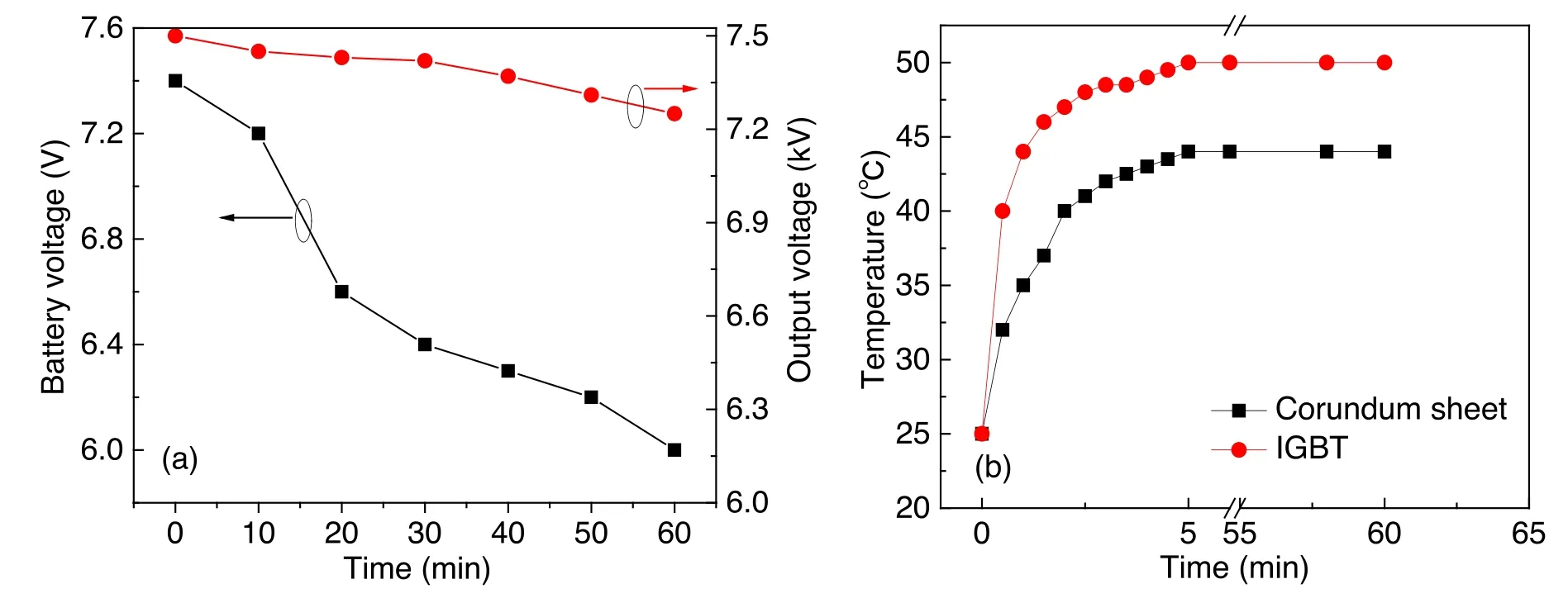
Figure 3.(a)The output performance of power supply and the rechargeable battery,(b)the temperature of IGBT and electrode vary with the operation time.
3.The characteristics of portable FE-DBD device
3.1.Experiment setup and discharge images
Figure 4 shows the experimental and diagnostic system for studying the characteristics of FE-DBD and optimizing the process parameters when the device is operated with a metal plate or human hand,respectively.The electrical characteristics are measured by a high voltage probe(Tektronix P6015A,1000:1)and a current coil(Pearson 4100,1A/V),and the signals are recorded using a digital oscilloscope(Tektronix TDS3045c).The discharge images are captured using a digital camera Canon EOS 6D with an exposure time of 0.5 s.

Figure 4.Schematic of the experimental and diagnostic system for the portable FEDBD operated with metal plate(a)and human hand(b).
The discharge images at different electrode gas gaps are captured using a metal electrode and a human hand,as shown in figure 5.The exposure time is set as 0.5 s,and the pulse voltage and frequency are 10 kV and 1 kHz,respectively.As shown in figure 5(a),the discharges with the human hand present a filamentary mode and cover the whole electrode.When the electrode gap increases,the discharge filaments become more obvious,and the discharge area slightly decreases.The morphology of the discharge with the metal plate is different from that with the human hand.More discharge filaments are observed,and the discharge area significantly decreases with the gas gap increasing.Under the same air gap conditions,the discharge area with a human hand is larger than that with the metal plate.The result indicates that it is easier to form streamer channels to enhance the partial discharge intensity when the FE-DBD is operated with the metal plate.
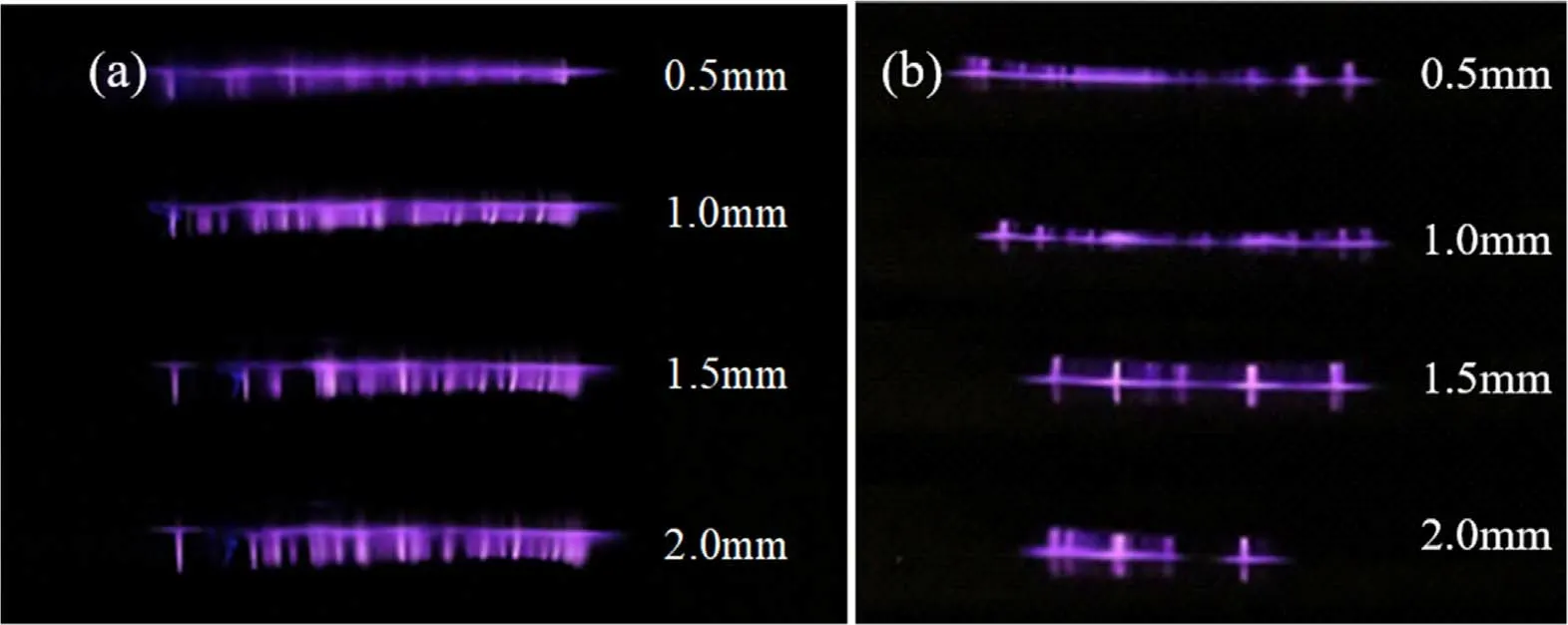
Figure 5.Discharge images of the FE-DBD device with human hand(a)and metal plate(b).
3.2.Electrical characteristics
Figure 6 presents the evolution of the pulse voltage and discharge current when the FE-DBD works with a metal electrode and human hand,respectively.The custom-made power supply can generate the output pulse voltage with the rising edge time of about 2.5 μs and a pulse width of 4.5 μs.The current curves in figure 6 show that two phase discharges occur during one pulse period,taking place at the voltage rising edge and one at the voltage falling edge.The applied electric field initiates the discharge at the rising edge.In contrast,the discharge at the falling edge is due to the air gap breakdown induced by the reverse electric field,derived from the charges accumulated on the dielectric[17].Moreover,multiple current peaks in the rising or falling edge indicate that both the two-phase discharges contain multiple micro-discharge channels and the discharges are generated in a filamentary mode.The current intensity also confirms that the discharge intensity with a human hand is weak compared to the metal electrode case.
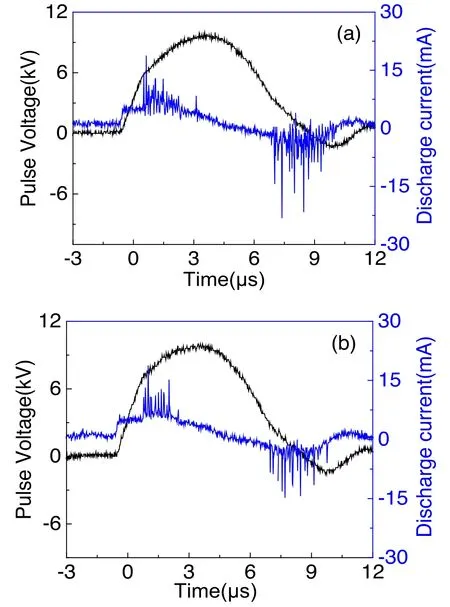
Figure 6.The evolution of the applied voltage and discharge current.(a)metal electrode,(b)human hand.
The average discharge power during one pulse period is calculated by:

where P is the average power,f is the pulse repetition frequency,u(t)is the pulse voltage and i(t)is the discharge current.According to the equation(1),the average powers with a metal electrode and human hand are determined to be 3.3 W and 2.3 W,respectively,with the pulse voltage of 11 kV and gas gap of 1 mm.Figure 7 presents the average power varies with the pulse voltage and gas gap when the FE-DBD works with metal and human hand,respectively.It can be seen from figure 7 that the average power increases with the pulse voltage and decreases with the gas gap distance.Under the lower pulse voltage and air gap distance conditions,the average power between the metal electrode and the human hand is small and increases with the pulse voltage and gas gap increase.
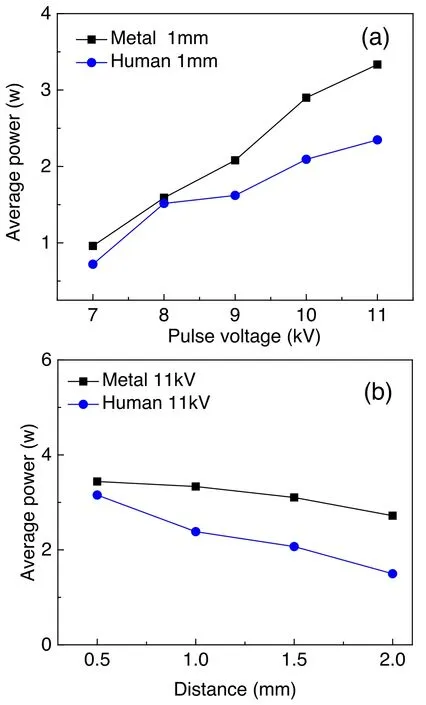
Figure 7.Average powers vary with the pulse voltage(a)and gas gap(b).
3.3.The safety of human contact
Though the experimental results have shown that the FEDBD device can operate with the human body as a ground electrode,a theory calculation is carried out to verify the experiment results.In this paper,the current through the human body is chosen as a criterion for evaluating the safety of operation.The current through the human body is estimated according to the equivalent impedance of the human body.The equivalent circuit is established and shown in figure 8,a series connection of the dielectric impedance Zd,the discharge air gap impedance Zgand the human body impedance Zh.The human body can be equivalent to a parallel connection of resistance(Rh)and capacitance(Ch).The gas gap is equivalent to a capacitance Cgbefore the discharge and a parallel connection of Cgand the series of a plasma capacitance Cpand resistance Rpafter the discharge[16,18].
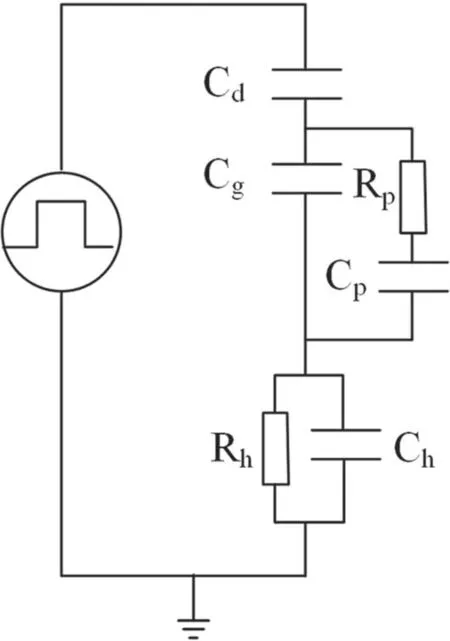
Figure 8.The equivalent circuit of FE-DBD with a human body as the ground electrode.
The capacitance of gas gap Cgand dielectric barrier Cdare calculated via equation(2)[18],whereε0is the vacuum dielectric constant,ε is the relative permittivity,S is the dielectric barrier(3.5 cm2),and l is the distance between the two plates of the capacitor.For the air gap,εg= 1.01,S=3.5 cm2and lg= 1 mm,and for the dielectric,εd= 6,S=3.5 cm2and lg= 1 mm,therefore,Cgand Cdare calculated to be 3 pF and 18 pF,respectively.When the frequency is 1 kHz,the corresponding impedance Zdand Zgare determined to be 12.24 and 52.8 MΩ

Due to the complex plasma processes,the plasma capacitance Cpand resistance Rpare not constant,and are also difficult to calculate accurately.Therefore,an estimated value of Cp=1 pF and Rp=242 Ω are adopted,according to the reference[19],and the plasma impedance Zpis estimated to be 19.8 MΩ.According to the previous research[16],when Chis 80 pF,Rhis about 1 MΩ.The impedance of the human body(Zh)is estimated to bevia equation(3)[18].When the floating electrode directly contacts the human body,the current through the human body is the largest.On this condition,the gas gap is approximately zero,and Zgcan be ignored.The total impedance Ztcan be expressed as the sum of Zdand Zh,and calculated to beFinally,the current through the human body is estimated to be 0.71 mA at the voltage of 8 kV,lower than the threshold current for human safety 10 mA[20].

4.Inactivation of Escherichia coli
The FE-DBD device is designed for the application of human wound treatment,especially wound sterilization.To verify the sterilization performance,Escherichia coli were selected as treated samples.200 μl Escherichia coli solution with the initial concentration of 5×106CFU ml-1was inoculated and spread onto the nutrient broth agar medium in the petri dish with a diameter of 80 mm.The samples were treated by the FE-DBD plasma with the pulse voltage of 9 kV and the discharge gap of 2 mm for different times and then cultivated for 24 h in a constant-temperature(37 degrees centigrade)incubator.The inactivation results are presented in figure 9.Due to the circular floating electrode,the treated area on the medium also presents circular shapes with diameters of~50 mm.As shown in figure 9(a),only a few colonies can be observed for the plasma treatment of up to 120 s.For the quantitative analysis,the plate counting method is used to estimate the number of Escherichia coli colonies and thus,to calculate the inactivation rate.The results in figure 9(b)show that the inactivation rate can reach about 70% for 60 s FEDBD treatment and approach nearly 98%for 120 s treatment.Previous research has confirmed that reactive oxygen and nitrogen species played significant roles in the microorganism inactivation[21,22].The plasma-generated reactive species can peroxidize the cell membrane and interfere with DNA replication and expression,destroying the cell[23].The plasma generated UV radiation and electrons may contribute to the inactivation of Escherichia coli.However,the UV radiation intensity and the electron density vary from discharge types,and their direct effects on bacterial inactivation are weak in many cases,which has been confirmed by several previous studies[24,25].
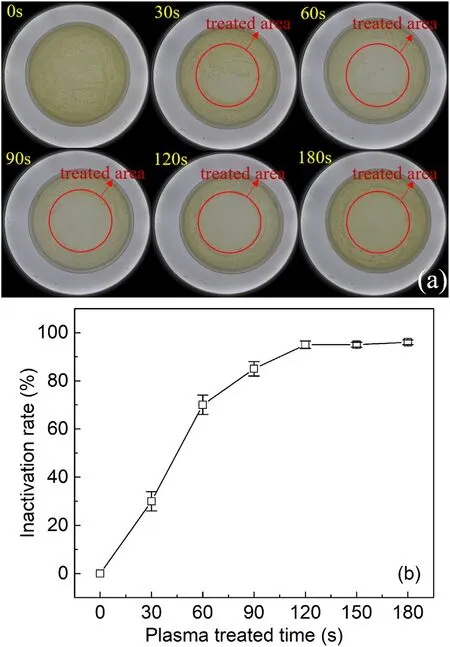
Figure 9.(a)The results of untreated and plasma-treated Escherichia coli samples cultivated for 24 h,(b)the inactivation rate ofEscherichia coli varies with the treated time.
Moreover,another notable phenomenon is the number of colonies in the areas without direct plasma treatment at 180 s also decreased significantly.This result indicates that the reactive species generated by the FE-DBD plasma diffuse on the medium,resulting in the inactivation of Escherichia coli.The inactivation experiment shows the good application potential of FE-DBD in the field of biomedicine.
5.Conclusion
In this paper,an FE-DBD device with an integrated miniaturized pulse power supply is designed,featuring the small volume of 56 mm × 56 mm × 150 mm and mass of 800 g.The miniaturized pulse power can output a voltage in the range of 7–12 kV with a microsecond rising edge.The floating electrode is made up of copper covered with a corundum dielectric.The electrical characteristic shows that the discharges present filamentary mode with a metal electrode and human hand.An equivalent circuit for the discharge with the human hand is established for verifying the human contact safety of the FE-DBD device.The calculated current through the human body is about 0.71 mA,which is much lower than the threshold current for human safety.Finally,the Escherichia coli inactivation experiment is carried out,and the treated Escherichia coli by the FE-DBD plasma can reach 98% for 120 s,showing a high efficiency in the bacterial inactivation.
Acknowledgments
This study is supported by National Natural Science Foundation of China(Nos.51907088,51677019).
猜你喜欢
杂志排行
Plasma Science and Technology的其它文章
- Special issue on selected papers from HVDP 2020
- Microwave transmittance characteristics in different uniquely designed one-dimensional plasma photonic crystals
- Burst pulses for positive corona discharges in atmospheric air:the collective movement of charged species
- Effect of plasma step gradient modification on surface electrical properties of epoxy resin
- Reconstruction of energy spectrum of runaway electrons in nanosecond-pulse discharges in atmospheric air
- The enhanced aerosol deposition by bipolar corona discharge arrays
